|
|
|
Joseph and
Helen Husser Residence, Chicago (1899 - S.046) |
|
|
|
Study of
The
Architectural Review - June 1901,
Plate XXXVII |
|
|
|
|
During the final stages of
the completion of the Husser Residence, Robert C. Spencer,
Jr. describes the home in the June 1900 issue of
The
Architectural Review. "Among the house plans those
for Mr. Husser and Mrs. Devin (project) are interesting
examples of the ground-floor treated as a basement. The
limitations of narrow lots have been offset by ingenious
planning for light and view, as well as for a dignified
route from street to reception hall. In both these houses
the interior composition is unusually broad and finished
with plenty of the third dimension. Here, as in all his
work, no thin and papery partitions are in evidence, yet
effects of mass and depth are not forced unduly in the
interest of the characteristic, plastic treatment, and
there are no hollow wall spaces which are not organized in
plan to practical purpose... The ornament should be of the
surface, not on the surface and there should be no tangible
background at all. That is the spirit in which the rich
frieze decorations of the Winslow, Heller and Husser houses
are designed...
"A very recent innovation not yet in place is the
facing of gold enamel and glass mosaic for one of the Husser
fireplaces. Quietly framed within broad bands of Caen stone,
the combination of |
|
gold in fusion with color on
porcelain have been made to delineate vine trunks and a
weeping profusion of wisteria sprays and pendent blossoms
upon a ground dull gold below and bright gold above a
suggested horizon. The white joints have been employed with
great skill to delineate dainty stems and leaves of softer
green and crackled gold. The sprays of blossoms are inlays
of rosy white and pearly glass which fall in the airiest,
sweetest fashion from the tangle of leaves above. Mr. Wright
as architect, Miss Ostertag as artist, and Mr. Giannini as
craftsman and burner of remarkable enamels, have co-operated
to show what may be conceived and executed here above and
beyond precedent. They have more than succeeded. No
monochrome can even suggest the exquisite beauty of this
facing in its splendent play of iridescent color, of which
the public has fortunately had a view at the recent
exhibition of the Architectural Club. This bit of mosaic is
for the Husser home, whose interior walls are of a dull
yellow brick engaged with deep toned and unvarnished wood
with inlaid lines of tawny gold mosaic that mark the
beginning of a new epoch in the use of permanent and
beautiful materials for domestic interiors in the west."
Below is a detailed look at Plate XXXVII. |
|
|
|
|
| Title:
Plate XXXVII - House for Mrs. Helen W. Husser, Buena Ave.,
Lake View, Ill. - Mr. Frank Lloyd Wright, Architect. |
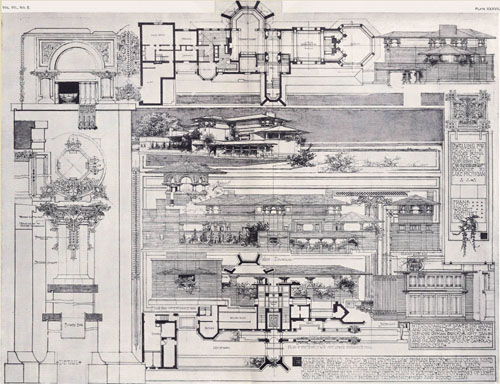 |
Inscription
Center Right: "Dwelling for Mr. Joseph W. Husser, Buena
Av. Lake View Suburban Lot. One Hundred and Thirty by One
Hundred Feet. Broadside to Lake Michigan. Frank Lloyd Wright
Architect, 1899."
Inscription
Near Bottom Right: "Interior Walls of Lower Entrance and
Principal Rooms Lined With Slender Roman Bricks. Light Tan
in Color Carrying Gold Insertion and Inlaid Bands of Olive
Oak. Plaster Dead Gold."
Inscription
Bottom Right: "Exterior Walls Faced With Dry-yellow
Roman Bricks.
Horizontal Joints Wide and Raked out to Emphasize Horizontal
Grain. Vertical
Joints Stopped Flush with Mortar the Color of the Bricks.
Stone Trimmings.
Terra Cotta Capitals. Frieze in Stucco Relief. Soffits Plain
in Plaster.
Roof Covering of Light Red Flat Tiles Without Modeled
Trimmings. Hips and
Ridges Clean."
Plate XXXVII published in "The Architectural Record", March
1908. Copyright 1900 By Bates & Guild Company. |
| |
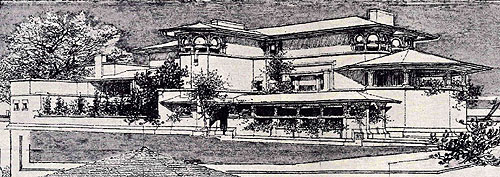 |
| 1) Viewed
from the Southwest. The Stable (lower level) is on the far
left. Just to the right of the Stable on the first level are
the Servants Quarters and then the Kitchen. The Dining Room
(East side), Stair Bay (West side) and Entrance (West side)
are in the center. The Living Room is on the right, and
Covered Porch on the far right. The covered Entrance Pergola
to the right of the Entrance is in the foreground on the
lower level. Bedrooms are located on the Second (top) level. |
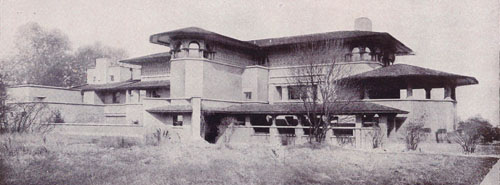 |
|
1b) Viewed from the
Southwest, Circa 1900. Published in "Frank
Lloyd Wright,
Chicago". |
|
|
 |
| 2) West
Elevation. The Stable (lower level) is on the far left. Just
to the right of the Stable on the first level are the
Servants Quarters and then the Kitchen. The Dining Room
(East side), Stair Bay (West side) and Entrance (West side)
are in the center. The Living Room is on the right, and
Covered Porch on the far right. The covered Entrance Pergola
is to the right of the Entrance on the lower level. Bedrooms
are located on the Second (top) level. |
| |
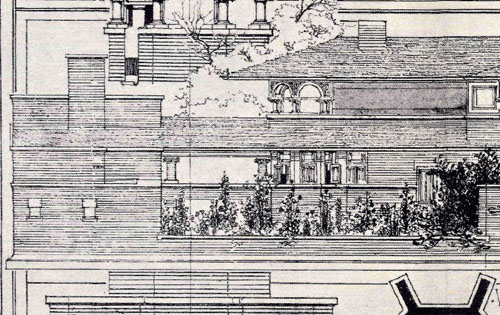 |
| 2a) Detail
of the West Elevation. The Stable (lower level) is on the
far left. Just to the right of the Stable on the first level
are the Servants Quarters and then the Kitchen. |
| |
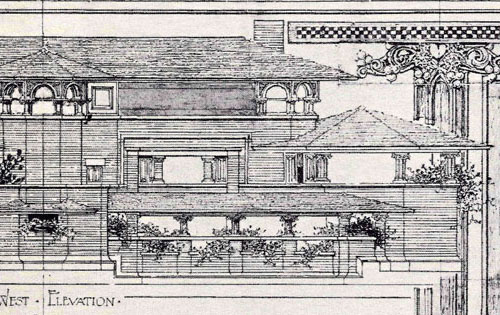 |
| 2b) Detail
of the West Elevation. The Dining Room (East side), Stair
Bay (West side) and Entrance (West side) are seen on the
left. The Living Room is seen in the center, and Covered
Porch on the right. The covered Entrance Pergola is to the
right of the Entrance on the lower level. |
| |
|
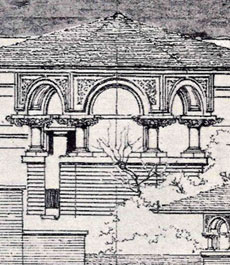 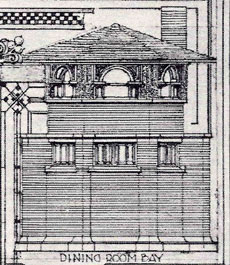 |
3) Left:
Detail of the Stair Bay (West side), top floor. Note
Wright's placement of cloth draped from open window.
4) Right: Dining Room Bay (East side) Dining Room is on the
first floor. |
| |
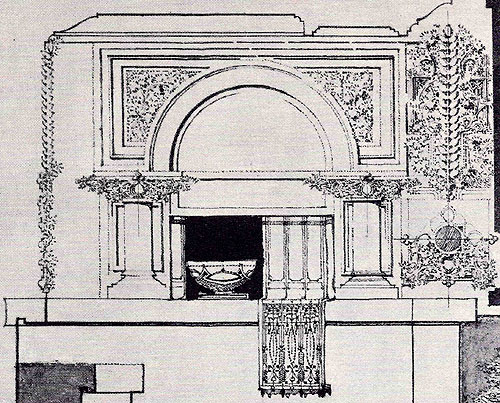 |
| 5) Detail
of the second level of the Dining Room Bay (East side). Note
Wright's placement of the vase and cloth tapestry draped
from open window. Wright included this detail on Plate IV of
the
Ausgeführte
Bauten. |
| |
 |
| 6) West
Elevation. The lower level of the Stair Bay and Entrance Way
is one the left. The covered Entrance Pergola is on the
right. |
| |
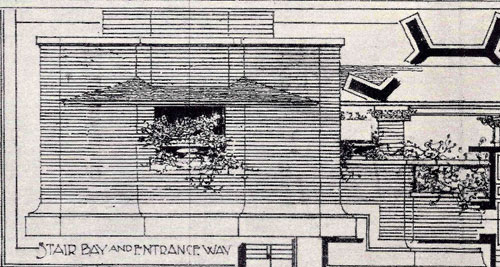 |
| 6a) West
Elevation. Detail of the lower level of the Stair Bay and
Entrance Way is on the left. Large vase sets in opening. The
covered Entrance Pergola is on the far right. |
| |
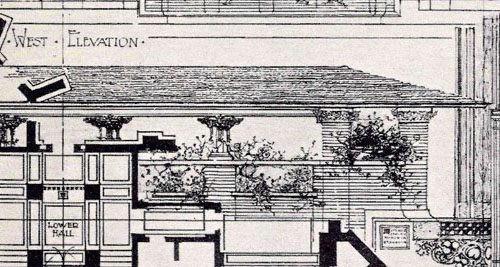 |
| 6b) West
Elevation. Detail of the covered Entrance Pergola. Large
vase sets on the ledge on the far right near the beginning
of the entrance to the covered Pergola. |
| |
|
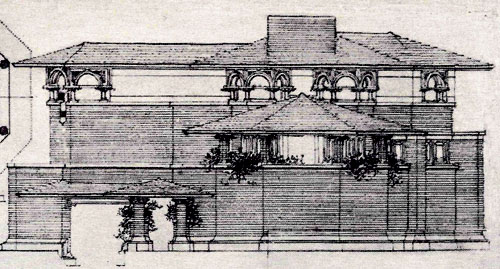 |
7) South Elevation. Lower
level: The opening on the left is the Driveway. From the
street, the Drive leads to the Porte Cochere (translated
carriage porch) which Wright designed into the lower level
of the Stair Bay. The Driveway leads through the lower level
of the Stair Bay to the Stable. Just to the right of the
Drive is the covered Entrance Pergola. Both the Drive and
the Entrance Pergola lead to the Entrance and the Lower
Hall.
First level: The Covered Porch is seen in the
foreground in the center. It leads into the Living Room on
the First Level.
First and Second Level: The Stair Bay (West side) can
be seen on the left. The main section of the house is seen
in the center behind the Covered Porch, and the Dining Room
(East side), can be seen on the right. Bedrooms are located
on the Second (top) level. |
| |
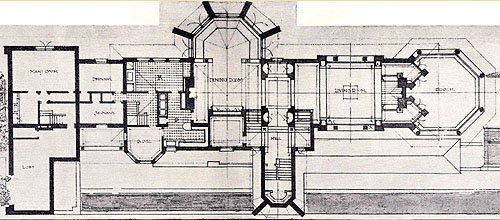 |
|
8) Floor plan for the First
level. Above the Stable to the left (North) is the Hay Loft
(West side) and the Man's Room or Servants Room on the east
side. Just to the right are two Servants rooms and a Porch.
Next is the Kitchen area which includes the Kitchen "K",
Pantry "P" and an alcove with the initials "B.D.R." which
served as a smaller informal Breakfast Dining Room. Just to
the right of the Kitchen area is the Dining Room that faced
East and a Study that faced West. Much like the windows in
Wright's Oak Park Dining Room, the windows allowed light,
but did not offer expansive views of the lake. Wright choose
rather to keep the it a more intimate setting. To the right
was the Stair Bay (West side). The Entrance to the home was
on the lower level of the Stair Bay, which lead into the
Lower Hall. Double stairways gave access to the main level
and lead to an Entrance Hall or "foyer" situated between the
Dining and Living Rooms. The Living Room offered expansive
views of Lake Michigan. The Covered Porch is on the far
right. |
| |
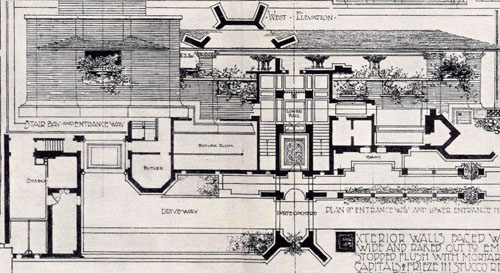 |
|
9) Floor plan for the Lower
level. Wright designed the Lower level as a basement,
although it was at ground level. This allowed the First
floor (second level) a better view of Lake Michigan. Wright
choose to give us only a glimpse of the rooms in the Lower
level. The Stable is on the far left. The area directly
beneath the "Breakfast Dining Room" was the Butlers Room. To
the right was the Stair Bay (West side). The Entrance to the
home was on the lower level of the Stair Bay, which lead
into the Lower Hall. Double stairways gave access to the
main level and lead to an Entrance Hall or "foyer" situated
between the Dining and Living Rooms on the First level. The
Porte Cochere (translated carriage porch) intersected the
lower level of the Stair Bay. |
| |
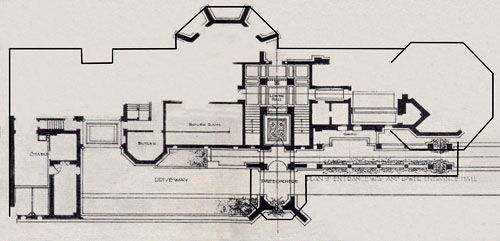 |
|
9a) Floor plan for the Lower
level with overlay. An outline from the layout of the First
level was laid over the layout for the Lower level. What
this revealed was the Wright's layout of the Lower and First
levels were not compatible. The width of the Lower level was
compressed to match the width of the layout for the First
level. If Wright's layout for the First level was more
complete, it could be the more accurate of the two layouts. |
| |
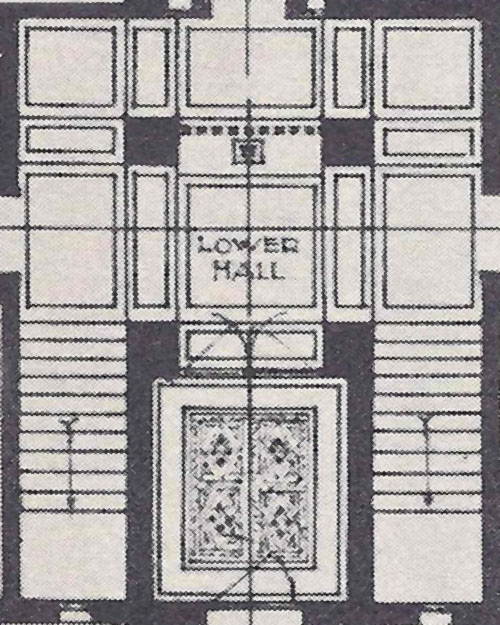 |
|
10) Floor plan of Entrance
and Lower Hall. As Guests disembarked from their carriages
in the Porte Cochere, they would enter a single door in the
Entryway then a set of double doors into the Lower Hall. The
pattern in the Entry could possible have been a mosaic
pattern in the floor. The Butler, having a view of the Porte
Cochere, would escort their guests up a set of double
stairways that gave access to the main level and lead to an
Entrance Hall or "foyer" situated between the Dining and
Living Rooms on the First level. |
| |
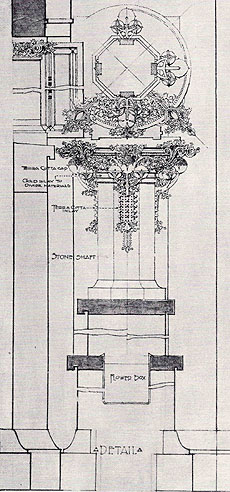 |
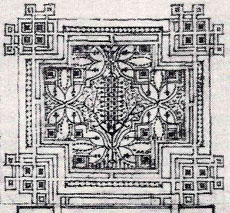 |
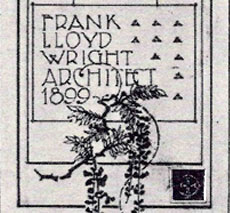 |
|
11) Detail of the
covered Entrance Pergola column. Three appeared on
either side. Wright included this detail on Plate IV
of the
Ausgeführte
Bauten. |
|
12) Design appearing above the
title on the right side.
13) Design appearing below the title on the
right side. Wright's logo is in the bottom right
corner. |
|
|
|
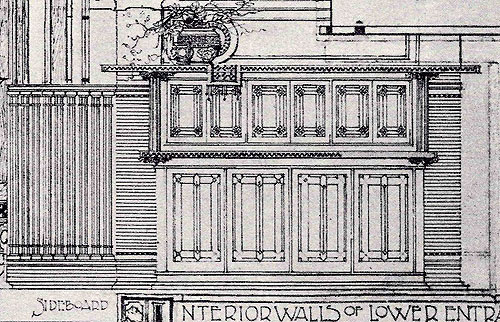 |
|
14) Detail of the interior
Dining room Sideboard. Located on the West side of the
Dining Room, the Study was located just behind the
Sideboard. Wood and leaded glass was positioned between two
brick columns. Wood spinals on the left created a partition
blocking the stairs which lead to the lower level. A triple
row checkerboard pattern (see below) was designed into the
top and the horizontal shelf between the upper and lower
Sideboard doors. This pattern was repeated throughout other
built-in pieces as well as the Dining Room tables. Although
designed into the upper and center horizontal pieces of the
Sideboard, it was only carved into the center piece. The
Living Room was located to the far left. Kitchen to the
right. |
| |
 |
|
15) Sideboard detail, left side,
upper half. This illustration shows the detail of the top of
the column between the upper and center horizontal pieces of
the Sideboard along with the leaded glass pattern of the
doors. The triple row checkerboard pattern was designed into
the top and the horizontal shelf between the upper and lower
Sideboard doors. |
| |
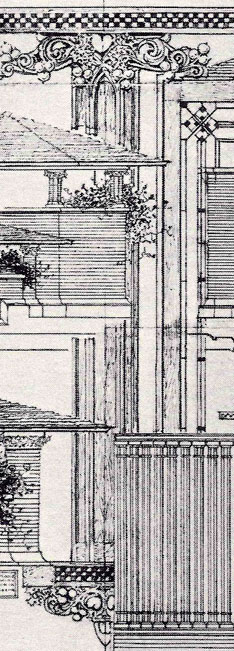 |
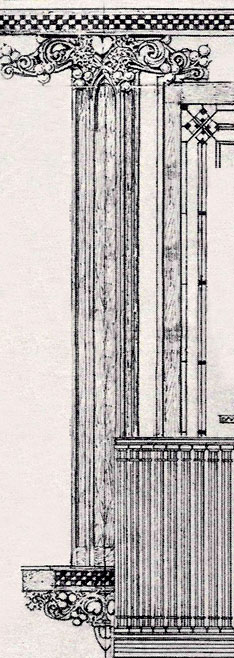 |
|
(Original Illustration) |
(Enhanced Illustration) |
|
16) Sideboard detail, left side,
upper half. This illustration shows the detail of the column
between the upper and center horizontal pieces of the
Sideboard and the leaded glass pattern of the doors (left
side of upper Sideboard). The triple row checkerboard
pattern was designed into the top and the horizontal shelf
between the upper and lower Sideboard doors. Although
designed into the upper and center horizontal pieces of the
Sideboard, it may have only been carved into the center
piece. |
| |
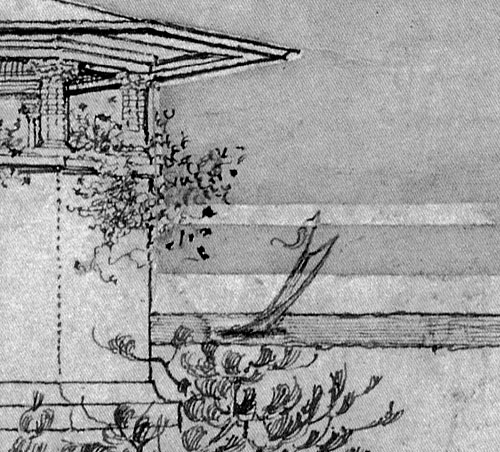 |
|
17) Although it may not be an
accurate depiction of the view of Lake Michigan in 1899, it
it gives us a view of Wright's perspective.. |
|
|
|

CLICK TO ORDER
























